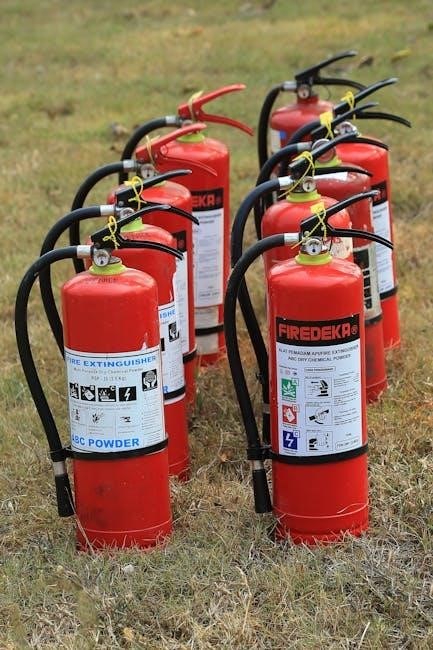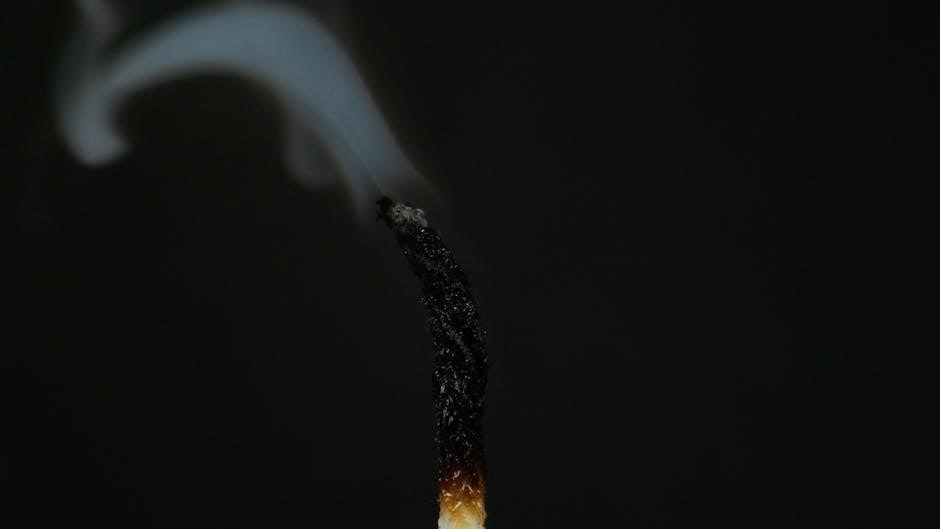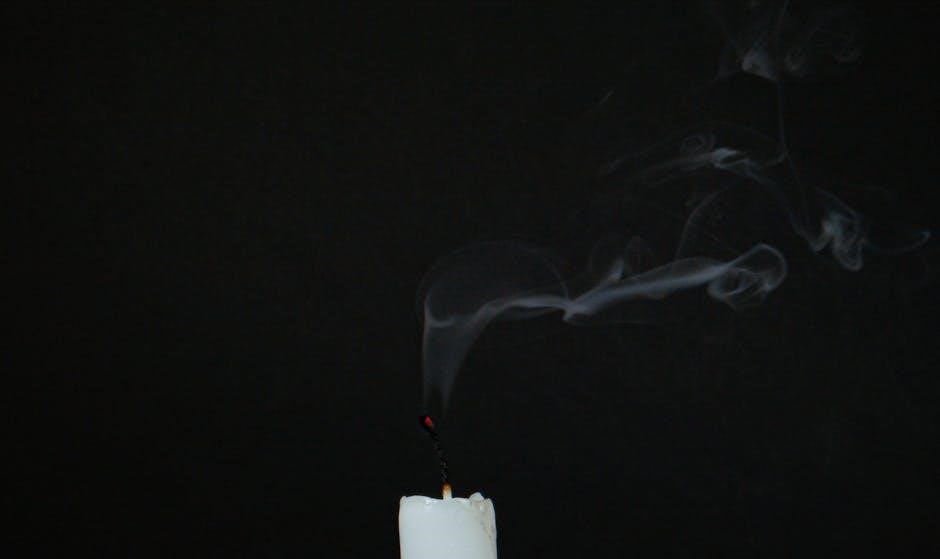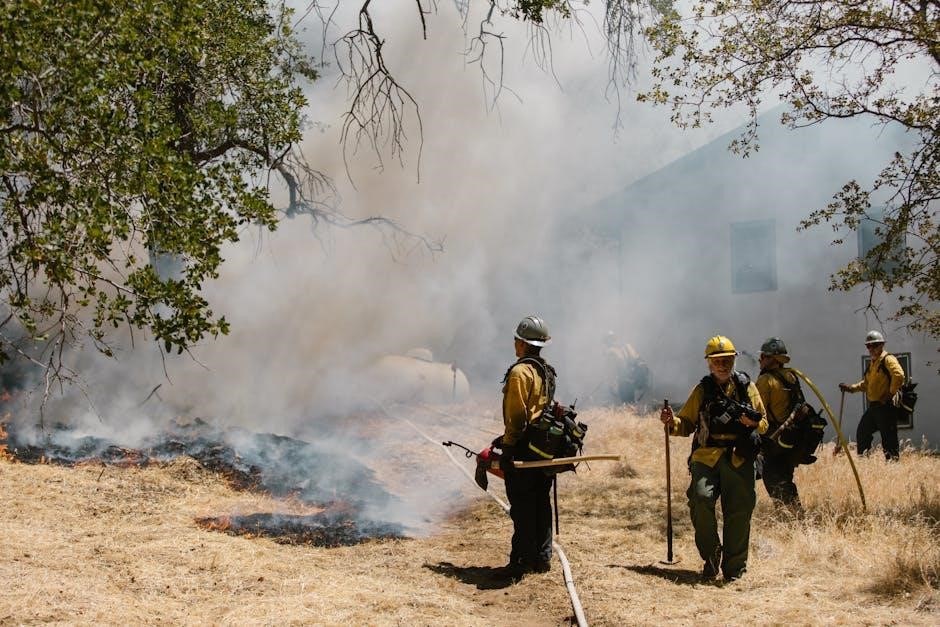Fire extinguishers are essential tools for controlling and extinguishing fires, preventing their spread and reducing potential damage. They are designed to address specific fire types effectively, ensuring safety and timely response in emergencies.

1.1 Importance of Fire Extinguishers in Fire Safety
Fire extinguishers play a vital role in fire safety by enabling individuals to control or extinguish small fires before they escalate. They provide a first line of defense, allowing people to act quickly and prevent fires from spreading. This is crucial for protecting lives, property, and assets. Fire extinguishers also facilitate safe evacuation by reducing fire intensity and smoke. Additionally, they are a legal requirement in many buildings, ensuring compliance with fire safety regulations. Their presence and proper use can significantly reduce fire-related injuries, fatalities, and property damage. By empowering individuals to take immediate action, fire extinguishers are indispensable in maintaining safety and minimizing risks during fire emergencies.
1.2 Brief Overview of Fire Classes (A, B, C, D, K)
Fires are categorized into five main classes based on the type of fuel involved:
- Class A: Involves ordinary combustibles like wood, paper, and textiles.
- Class B: Pertains to flammable liquids or gases, such as gasoline or propane.
- Class C: Refers to fires involving electrical equipment, where electricity is a factor.
- Class D: Deals with combustible metals, such as magnesium or aluminum.
- Class K: Involves cooking oils and fats, typically in commercial kitchens.
Understanding these fire classes is essential for selecting the appropriate extinguisher, as each type of fire requires a specific suppression method to ensure effectiveness and safety.

Types of Fire Extinguishers
Fire extinguishers are categorized by their extinguishing agents, including water, foam, dry powder, carbon dioxide, and wet chemical, each designed for specific fire types to ensure effective suppression.
2.1 Water-Based Fire Extinguishers
Water-based fire extinguishers are the most common and cost-effective type, suitable for Class A fires involving ordinary combustibles like wood, paper, and cloth. They work by cooling the fuel source, reducing the temperature below the ignition point. These extinguishers are available with jet or spray nozzles, offering different pressure levels. A specialized version, water mist extinguishers, uses de-ionized water to create a fine mist, effective on Class A, B, and C fires. However, they are less ideal for electrical fires compared to CO2 extinguishers. Water-based extinguishers are widely used in homes, offices, and commercial spaces due to their simplicity and effectiveness on common fire hazards.
2.2 Foam Fire Extinguishers
Foam fire extinguishers are versatile and effective for combating Class A and Class B fires. They work by discharging a mixture of water and foam concentrate, creating a thick, insulating barrier that smothers the fire and prevents re-ignition. The foam starves the fire of oxygen and cools the fuel, making it ideal for fires involving solids, flammable liquids, or gases. These extinguishers are commonly used in industrial settings, garages, and areas with hazardous materials. Foam extinguishers are environmentally friendly and leave minimal residue, but they are not suitable for electrical fires or deep-seated fires in solid materials. Their wide range of applications makes them a popular choice for general fire safety needs.
2.3 Dry Powder Fire Extinguishers
Dry powder fire extinguishers are multi-purpose devices designed to combat various fire classes, including Class A, B, and C fires. They discharge a fine, non-conductive powder that smothers the fire by separating fuel from oxygen. This makes them effective for fires involving ordinary combustibles, flammable liquids, and electrical equipment. However, dry powder extinguishers are not recommended for Class D fires involving combustible metals, as they do not provide the necessary chemical reaction to extinguish such fires. Additionally, they should be avoided in confined spaces due to visibility issues and inhalation risks. Regular maintenance is crucial to ensure the powder remains effective and free-flowing, making them a reliable choice for general fire safety in diverse environments.
2.4 Carbon Dioxide (CO2) Fire Extinguishers
Carbon dioxide (CO2) fire extinguishers are highly effective for Class B and Class C fires, which involve flammable liquids, gases, and electrical equipment. They work by displacing oxygen, thereby suffocating the fire and preventing further combustion. CO2 extinguishers are particularly useful in environments with sensitive electrical equipment, as they leave no residue after use. However, they are not suitable for Class A fires, as they do not cool the burning material, potentially allowing the fire to reignite. Additionally, CO2 extinguishers are ineffective against Class D and K fires. They are widely used in commercial and industrial settings due to their clean and non-corrosive properties, making them ideal for protecting valuable assets without causing additional damage.
2.5 Wet Chemical Fire Extinguishers
Wet chemical fire extinguishers are specialized for Class K fires, primarily involving cooking oils and fats. They discharge a potassium-based solution in a fine mist, cooling the oil and forming a soapy foam that prevents reignition. Unlike water, which can splatter oil and worsen the fire, wet chemical extinguishers are designed to contain and smother cooking oil fires effectively. They are commonly used in commercial kitchens, restaurants, and food processing areas where such fires are a significant risk. Wet chemical extinguishers are not suitable for other fire classes, such as Class A or B, making them a targeted solution for specific high-risk environments. Their effectiveness in controlling dangerous oil fires makes them a critical component of fire safety in the culinary industry.

Fire Extinguisher Uses by Fire Class
Fire extinguishers are matched to fire classes to ensure effective suppression. Class A uses water, Class B requires foam or CO2, Class C needs non-conductive agents, and Class K involves wet chemicals for cooking oils, ensuring targeted fire control.
3.1 Class A Fires (Ordinary Combustibles)
Class A fires involve ordinary combustibles such as wood, paper, cloth, and plastics. These fires are common in homes and workplaces, often starting from everyday materials. Water-based fire extinguishers are the most effective for Class A fires, as they cool the fuel source, reducing temperatures below the ignition point. Other extinguishers, like foam or dry powder, can also be used but are less efficient. It is crucial to act quickly, as Class A fires can spread rapidly, especially in environments with abundant combustible materials. Proper use of water extinguishers ensures effective suppression and prevents re-ignition, making them the first choice for Class A fire scenarios.
3.2 Class B Fires (Flammable Liquids and Gases)
Class B fires involve flammable liquids or gases, such as gasoline, propane, or paint. These fires are highly dangerous due to the potential for rapid spreading and explosion. Carbon dioxide (CO2) and dry powder extinguishers are commonly used to suppress Class B fires, as they effectively smother the fuel source by displacing oxygen. Foam extinguishers are also suitable, as they create a barrier between the fuel and oxygen, preventing reignition. Water-based extinguishers are not recommended, as they can cause the flammable liquid to spread. Proper use of the right extinguisher is critical to prevent the fire from escalating and to ensure safety in hazardous environments.
3.3 Class C Fires (Electrical Equipment)
Class C fires involve electrical equipment, such as appliances, circuit breakers, or wiring. These fires are particularly dangerous due to the risk of electric shock and the complexity of their fuel sources. Carbon dioxide (CO2) extinguishers are the most effective for Class C fires, as they are non-conductive and do not damage electrical equipment. Dry powder extinguishers are also suitable, as they smother the fire without conducting electricity. Water-based extinguishers should never be used, as they can cause electrical shocks and worsen the situation. Properly addressing Class C fires requires careful selection of non-conductive extinguishing agents to ensure both fire suppression and operator safety in potentially hazardous electrical environments.
3.4 Class D Fires (Combustible Metals)
Class D fires involve combustible metals such as magnesium, aluminum, or sodium. These fires are highly dangerous due to the intense heat and reactive nature of burning metals. Water and other common extinguishing agents can worsen Class D fires, as they may cause violent reactions or spread the fire. Specialized dry powder extinguishers are required to combat Class D fires effectively. These extinguishers use agents like sodium chloride or graphite-based powders, which smother the fire by starving it of oxygen and cooling the metal. Proper training is essential for handling Class D fires, as incorrect methods can lead to severe consequences. Always use specifically designed equipment for these unique fire scenarios to ensure safety and effective fire suppression.
3.5 Class K Fires (Cooking Oils and Fats)
Class K fires involve cooking oils and fats, typically occurring in commercial kitchens. These fires are particularly dangerous due to the high temperatures and splashing of oil when improperly extinguished. Wet chemical fire extinguishers are specifically designed to combat Class K fires. They release a foamy agent that smothers the fire, cools the oil, and prevents reignition by forming a barrier between the fuel and oxygen. Water and other extinguishing agents are unsuitable, as they can cause the oil to splash and worsen the fire. Wet chemical extinguishers are essential in kitchens and food service areas to ensure effective and safe fire control. Regular maintenance and inspection of these extinguishers are critical to guarantee their reliability in emergencies.

Fire Extinguisher Color Coding and Identification
Fire extinguishers are color-coded for quick identification. Each color represents the extinguishing agent inside, such as red for water, blue for CO2, and cream for foam. Labels and symbols provide clear guidance on their use, ensuring users can act swiftly during emergencies.
4.1 Standard Colors for Fire Extinguishers
Fire extinguishers are color-coded to ensure quick identification in emergencies. The standard colors include red for water-based extinguishers, cream for foam, blue for CO2, black for dry powder, and green for wet chemical extinguishers. These colors help users instantly recognize the type of extinguishing agent, making it easier to select the correct one for the fire class. For example, red extinguishers are used for Class A fires involving ordinary combustibles, while blue CO2 extinguishers are suited for Class B and C fires. This color coding system is universally recognized, enhancing safety and efficiency during fire incidents. Proper identification ensures the right extinguisher is used, maximizing fire suppression effectiveness and minimizing risks. This system is a critical component of fire safety protocols worldwide.
4.2 Labels and Symbols for Easy Identification
Fire extinguishers are equipped with clear labels and symbols to ensure easy identification and proper use. These labels typically include pictograms representing the types of fires the extinguisher can tackle, such as flames for Class A fires or lightning bolts for Class C electrical fires. Symbols are universally recognized, allowing quick comprehension even in stressful situations. Additionally, labels provide essential information like operating instructions, agent type, and fire class suitability. Standardized symbols ensure consistency across regions, making it easier for individuals to understand and use extinguishers effectively. This visual system enhances safety by reducing confusion during emergencies, ensuring the correct extinguisher is selected for the specific fire type. Clear labeling and symbols are critical for effective fire management and user confidence. They play a vital role in fire safety education and preparedness.

Choosing the Right Fire Extinguisher
Selecting the appropriate fire extinguisher involves assessing fire risks, understanding fire classes, and ensuring compliance with safety regulations to guarantee efficacy in emergency situations.
5.1 Assessing Fire Risks in Different Environments
Evaluating fire risks involves identifying potential hazards in specific settings, such as residential, commercial, or industrial areas. Each environment has unique fire risks, including flammable materials, electrical equipment, and cooking oils. Understanding these risks helps determine the most suitable fire extinguishers. For example, commercial kitchens require Class K extinguishers for cooking oils, while industrial sites may need Class D extinguishers for combustible metals. Assessing the layout and occupancy of a space also ensures proper placement of extinguishers, making them easily accessible during emergencies. Regular inspections and updates to risk assessments are crucial to maintain fire safety standards and adapt to changing conditions. This proactive approach ensures preparedness and minimizes fire-related dangers effectively;
5.2 Compliance with Fire Safety Regulations
Adhering to fire safety regulations ensures legal compliance and enhances overall safety. Fire extinguishers must meet standards set by authorities, such as the NFPA, which outlines requirements for installation, inspection, and maintenance. Proper labeling and color coding of extinguishers, like red for water and blue for CO2, aid in quick identification. Buildings must have extinguishers appropriate for the fire risks present, such as Class A for ordinary combustibles or Class K for cooking oils. Regular inspections and maintenance by certified professionals are mandatory to ensure functionality. Non-compliance can result in penalties, making it crucial for organizations to stay informed and adhere to these regulations to protect people, property, and avoid legal consequences. Compliance ensures preparedness and effectiveness in fire emergencies, safeguarding lives and assets.
5.3 Maintenance and Inspection Requirements
Regular maintenance and inspection of fire extinguishers are critical to ensure their reliability in emergencies. Visual inspections should be conducted monthly to check for damage, corrosion, or tampering. Annual professional inspections are mandatory, covering internal components and recharge needs. Pressure gauges must indicate proper levels, and all components, such as hoses and nozzles, should function correctly. Maintenance records must be kept, detailing inspection dates and corrective actions. Cleanliness is essential; extinguishers should be protected from dust and moisture to prevent malfunction. Non-compliance with these requirements can lead to equipment failure, compromising safety. Proper upkeep ensures extinguishers remain ready to control or extinguish fires effectively, safeguarding lives and property from potential threats.